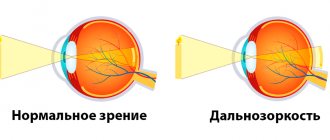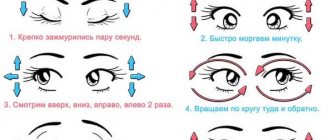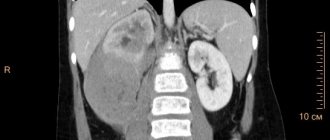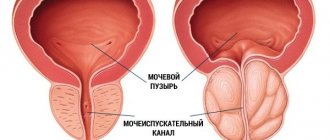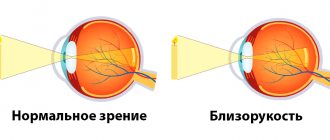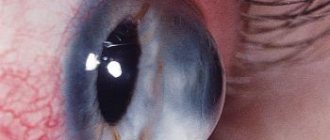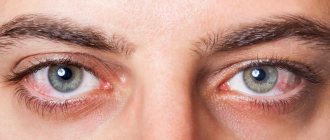Doctor:
Pristalenko Olga Valentinovna
Farsightedness , or scientifically hypermetropia , is a defect in visual perception during which the visibility of objects located both near and far is reduced. Farsightedness is present in all newborn children, which is due to the physiological characteristics of the optical system of the eyes and is a normal variant.
But in some cases, the pathology persists in the future; additional symptoms arise in the form of burning and rapid eye fatigue, headaches, decreased vision, and strabismus.
Hypermetropia is a rather dangerous disease, because only very attentive parents can notice hidden symptoms, and only an ophthalmologist can make a final diagnosis. Timely treatment in children allows you to get rid of the pathology forever.
Norm and pathology for hypermetropia
Hypermetropia is normally present in young children (1-3 years old), does not cause concern and does not require treatment. During the period of development between infancy and school age (up to 6-7 years), active growth occurs, the child’s body weight increases, and internal organs and systems develop. Particularly active development occurs in the visual system - an exact ratio of the functionality of different parts of the eyeball is developed.
In children by the age of four, this defect in visual perception disappears. Experts believe that it is possible to detect the disease and distinguish it from the norm from the first months of life. If farsightedness is detected in children above the age-normal value, treatment is required.
It is very important to begin therapy immediately after diagnosis, as school-age children are subject to increased eye strain. In the future, in the absence of eye correction, the symptoms of hypermetropia intensify.
Causes
Hypermetropia occurs due to the irregular shape of the eyeball. Often pathological changes occur in childhood. The fact is that all children have congenital farsightedness, but as the child grows, his eyeballs grow, and his vision becomes normal. This usually happens by the age of 4 years.
Over time, the lenses lose their ability to change. This begins to happen at the age of 25, but usually until the age of 45 it is not felt at all. At the age of 60, the lens completely loses this ability. This is why senile farsightedness occurs.
Features of hypermetropia
In childhood farsightedness, a disorder of the visual analyzer is characterized by focusing of the image not on the visual part of the retina, but beyond it. Symptoms are manifested by the inability to distinguish between objects that are nearby, but which the child can clearly distinguish at a far distance. Thus, children with this defect cannot concentrate on a toy that is located next to them.
Clarity of vision and visibility of objects far and near are ensured by the accommodation apparatus. Focusing the image on the retina occurs due to a change in the curvature of the lens, for which the ciliary muscle (ciliary) is responsible. In order to clearly see objects at close range, the ciliary muscle tenses, and the lens becomes more convex and the refraction of light occurs more strongly. For distance vision, the lens becomes flat due to relaxation of the ciliary muscle. Thus, in order to view objects well at different distances, the curvature of the lens is constantly changing. The refractive index of the lens is measured in diopters.
In children from birth, the eye is characterized by hypermetropia, which gradually decreases with eye growth and disappears completely by the age of 7 years. This condition in infants is considered normal and is characterized by an incompletely formed visual analyzer.
Classification of farsightedness
Severity of hypermetropia in children:
- The weak stage of farsightedness is characterized by indicators up to 2 diopters inclusive - children have no symptoms due to compensation for the accommodative abilities of the visual organ. The first stage of the disease is detected during preventive examinations and can be easily corrected with the help of special eye exercises.
- Average degree of pathology (from 2.25 to 5 diopters) - the child sees poorly near, but can clearly distinguish distant objects.
- High degree of impairment (5.25 diopters and above) – vision is significantly reduced, both near and far.
Treatment and correction of farsightedness
For farsightedness, treatment is aimed at:
- reduction of accommodation load;
- preservation of binocular vision;
- restoration of visual acuity and clarity;
- elimination of asthenopia (visual discomfort);
- preventing complications.
When treating farsightedness, it is necessary to take into account the cause of the pathology, the degree of impairment, symptoms, the presence of concomitant diseases and complications, the accommodative abilities of the eye, the patient’s age, and the expected visual load.
The most common way to correct farsightedness is the use of optical devices (glasses and contact lenses). In this case, spherical or spherocylindrical lenses are used, which shift the focus to the retina.
For farsighted people who cannot wear glasses, the doctor may recommend drug therapy - the use of miotics. These drugs cause an artificial spasm of accommodation, which allows you to temporarily compensate for eye hyperopia. But they cannot be used often due to the ability to cause serious adverse reactions. Vitamin and mineral complexes will help maintain eye tone and improve visual acuity.
Eye exercises and the use of the MAKDEL-09 apparatus will be effective in the fight against hypermetropia. The laser beam performs a non-contact physiological massage, thereby relieving visual fatigue, eliminating accommodative spasm, and restoring the tone of the eye muscles.
Among the surgical methods for treating farsightedness, photorefractive laser operations are most often performed.
Etiological factors in the development of childhood farsightedness
The reasons for the development of farsightedness in childhood are:
- genetic factors; malformations of the visual system, incorrect formation of eye structures;
- disturbance of intrauterine growth of the fetus;
- traumatic eye damage from chemical compounds or physical factors;
- conditions after infectious processes;
- operations on the visual organ;
- increased stress, eye fatigue;
- incorrectly selected glasses or contact lenses.
Clinical picture of hypermetropia
With a weak degree of farsightedness, there are no symptoms of impaired visual function. Therefore, during this period, it is important for parents to monitor the child’s changed behavior. Signs of hypermetropia in the early stages of the disease appear:
- rapid blinking;
- moodiness and irritability;
- constant headaches, dizziness;
- inability to concentrate on toys and any other objects located close or in the hands;
- increased eye fatigue for no apparent reason;
- sleep disturbance;
- inflammation of the eyeball, hyperemia, dryness;
- increased lacrimation.
The middle stage of the disease is more often diagnosed in children during preventive examinations by an ophthalmologist at school age. The picture described above may manifest itself with more vivid symptoms. The main manifestations of moderate farsightedness are poor visibility of objects at close range and their blurriness. The child has difficulty reading and writing. Such patients are mistakenly diagnosed with dysgraphia, dyslexia, or developmental delay. With a high degree of hypermetropia, the child complains of poor visibility of near objects and distant objects. With hypermetropia, convergent strabismus often develops, and there are disturbances in binocular vision.
Diagnostic measures
Get a complete vision examination at the Lege Artis Eye Clinic
It's time to correct your vision!
Make an appointment by phone:
8(804) 333-02-14 Free call
Diagnosis of hypermetropia in children is carried out by an ophthalmologist. Visual acuity testing is carried out using different methods, depending on the age of the child. Also, before the study begins, drops are instilled into the eye to dilate the pupil. This leads to relaxation of the ciliary muscle and allows you to correctly measure the light refractive ability of the eye. For timely detection of farsightedness, it is recommended to visit a pediatric ophthalmologist at least once a year.
Diagnosis consists of collecting an anamnesis, parents provide complete information about the child’s behavior and present complaints: a child with problems with visual perception quickly gets tired, becomes withdrawn, has a predominant bad mood, school-age children are characterized by slow reading, but bright pictures at a distance (billboards, posters) they look at with great interest.
To identify farsightedness, different diagnostic methods are used:
- visometry - tables with pictures are used for children, tables with letters are used for middle school children;
- determination of violations of the refractive power of the eye is carried out using autorefractometry, necessarily in conditions of cycloplegia: drug dilation of the pupil and switching off accommodation;
- skiascopy and retinoscopy.
What is farsightedness (hyperopia)
A feature of eye refraction in which the image of objects is not focused on the retina.
Farsightedness (hypermetropia) is a device of the optics of the eye when the focus of the image from an object falls not on the retina, but behind it, i.e. for an eye. The farsighted eye has a short size of 20-22 mm, while the normal eye length is 23.5 mm. With farsightedness, the eye is smaller in length than normal. Reducing the length of the eye by 1 mm from the norm gives +3.0 diopters of farsightedness! In total, about 10% of the population suffers from hypermetropia. Acquired farsightedness appears with age and is much more common than congenital farsightedness. As a rule, it affects people 25-40 years old, but sometimes it appears at a younger age. The main causes of acquired hypermetropia:
- Eye injuries.
- Operations on the eyes.
- Eye diseases.
- Work involving daily, prolonged eye strain.
Patients with a congenital visual defect may not be aware of it. Those who have acquired this anomaly immediately experience discomfort.
Degrees of farsightedness (hyperopia)
Depending on the optical power of the eye, hypermetropia is usually divided into 3 degrees:
- 1st degree - mild hypermetropia up to +2.0 diopters
- 2nd degree - Moderate hypermetropia from +2.25 to +4.0 diopters
- 3rd degree - High degree hypermetropia over +4.25 diopters
Vision with mild farsightedness remains virtually unchanged. Farsightedness up to +2.0 diopters can manifest itself as increased eye fatigue when working at close range for a long time. At an earlier age than normal, the need for reading glasses appears.
Diagnosis of farsightedness
If you have any of the above vision problems, you should consult an ophthalmologist. Why do you need a doctor? Because farsightedness can be complicated by defects such as myopia and astigmatism and have varying degrees, for example:
- Weak – up to +2 D.
- Average – + 2+5 D.
- High – above 5 D.
Additionally, each eye can see differently.
The ophthalmologist determines the degree of farsightedness using a table with letters or numbers of different sizes. However, this method is sometimes ineffective: when a person sees well into the distance and the degree of hypermetropia is weak. There are other diagnostic methods.
Perimetry
A study of the field of view on a concave circular surface, which is done using an arc, projection or computer perimeter (research apparatus). This method allows you to distinguish farsightedness from other vision defects.
Ophthalmoscopy
Examination of the fundus of the eye, which is carried out using an ophthalmoscope (fundus lens). The method allows you to identify disorders such as retinal tears, pathology of the blood vessels of the eye.
Goneoscopy
A method that allows the doctor to see the condition of the anterior chamber of the eyeball. It is carried out using goneolenses, a slit lamp and a microscope.
A set of diagnostic methods allows the doctor to make the correct diagnosis and prescribe the optimal method of vision correction.
Methods of vision correction for farsightedness
Before treating hypermetropia, the age of the patient should be taken into account. Treatment of a child with mild farsightedness does not require the use of conservative and modern correction methods, since vision can be restored along with the growth of the eyeball. It is recommended to take vitamins A, E, B. They improve blood supply to blood vessels and thereby help the eyeball to grow. When the cause is injury or illness, anti-inflammatory eye drops will help.
If the disease cannot be corrected, for example: irreversible injuries or hereditary predisposition, then other types of operations are needed.
Laser correction
Treatment with laser beams is used for mild to moderate hypermetropia. The essence of the operation is to change the shape of the cornea so that the image falls on the retina. The method is contraindicated for thin corneas and children under eighteen years of age.
Lens replacement
The operation is used for age-related farsightedness of medium and high degree. Lens replacement involves making an incision into the tissue of the eyeball to remove the natural lens from the eye and install an implant. The operation is indicated for age-related farsightedness, the degree of which is higher than five diopters.
Implantation of an intraocular lens
The surgery involves inserting a small toric lens into the posterior chamber of the eye. It refracts light correctly and vision is normalized. Such implantation is relevant for any degree of farsightedness and has almost no contraindications.
Contact lenses
For correction, spherical lenses with the required refractive power, which is indicated in diopters, are needed. They are installed on the surface of the eyeball and held in place for centuries. This treatment has a minimum number of contraindications and can be used in children from the age of eight. Contact lenses correct any degree of farsightedness.
Glasses
The most common method of vision correction. Usually, to improve vision in case of farsightedness, the ophthalmologist selects glasses with spherical lenses from +1 to +12 D. The glasses of such glasses visually enlarge the eyes. The method has no contraindications and is actively used to correct hypermetropia.
Treatment methods for hypermetropia in children
Farsightedness is treated conservatively in children under 18 years of age. If there is no positive effect after adulthood, microsurgery or laser vision correction is used.
Starting from a very early age - from several months of life - optical means for vision correction - glasses or contact lenses - are used. Spectacle correction is the most common due to its availability and low cost. Pleoptic hardware treatment is used to develop visual acuity. You can get high positive results and remove glasses in the future only if you choose the right lenses. To do this, a diagnosis is carried out, after which the doctor writes a prescription for the necessary glasses. Parents can choose the frame themselves; it is advisable to give preference to materials such as carbon or plastic. These frames are durable, reliable and light, and do not cause discomfort. To ensure that your child wears glasses without whims, it is better to choose frames in the child’s favorite color scheme.
Some parents and their doctor select contact lenses to correct farsightedness, as they have their advantages - first of all, the lenses do not slip or get dirty, and do not interfere with the child’s participation in active sports.
Prices for diagnostic services and consultation with an ophthalmologist
| Type of medical service | Service price in rubles |
| Complete ophthalmological examination | 1000 |
| Complete ophthalmological examination of children | 1100 |
| Consultation with an ophthalmologist for eye disease in an adult | 500 |
| Consultation with an ophthalmologist for eye diseases in children over 3 years of age | 700 |
| Selection of simple glasses with a prescription | 500 |
| Selection of glasses for astigmatism with a prescription | 700 |
| Selection of progressive, office glasses with prescription | 700 |
| Selection of contact lenses with training and prescription | 1000 |
| Training in the use of contact lenses | 400 |
Treatment methods
Complete ophthalmological examination
Has your visual acuity decreased or are you experiencing increased eye fatigue? Do you suffer from watery or dry eyes? Do you have chronic eye diseases? Our clinic specialists will conduct a full examination and identify the presence/absence of eye pathologies.
Hardware treatment of eyes in children
Treatment with ophthalmological devices makes it possible to achieve a lasting therapeutic effect in young patients. In some cases, it is possible to completely get rid of pathologies such as amblyopia, impaired binocular vision, and false myopia.
Presbyopia or vision after 40
Presbyopia occurs after 40 years of age and is characterized by decreased vision at close distances. In order not to aggravate the situation, you should follow your doctor’s recommendations and use modern vision correction devices.
Selection of glasses
The selection of glasses is a necessary measure that will ensure the owner is able to see clearly. Experienced doctors select spectacle lenses taking into account many measured parameters and taking into account the slightest deviation from the norm.
Varilux progressive lenses
Varilux lenses are an excellent tool for correcting age-related changes that occur in the organs of vision after 40 years. They provide excellent, clear images regardless of the distance to the subject in question.
This is interesting
Blue light and optical coatings that reduce its transmission
What diseases can be diagnosed based on the condition of the eyes?
Preserving vision and eye health with Crizal Eyezen lenses
Protect your eyes from the sun with UV filter contact lenses
Which spectacle lenses should I choose? Choose your glasses with Crizal Corner
